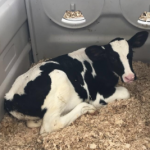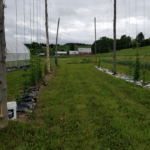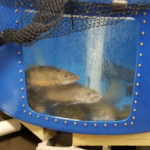-Summer Cardarelli ’21 and Andrew Lapp ’20
At the end of May, the garden team along with the sustainability interns took a tour of the Morrisville State College  Agriculture department in order to learn more about the methods used by a more agriculture centered school. We had the opportunity to visit Morrisville’s Dairy Complex, its greenhouse, its aquaponics buildings, as well as the Spader Horticulture Complex. On this tour, we were able to learn a lot about the techniques used by the college to maintain such a successful agriculture department. Much of what we observed, especially in their greenhouse, could be relevant to our own garden.
Agriculture department in order to learn more about the methods used by a more agriculture centered school. We had the opportunity to visit Morrisville’s Dairy Complex, its greenhouse, its aquaponics buildings, as well as the Spader Horticulture Complex. On this tour, we were able to learn a lot about the techniques used by the college to maintain such a successful agriculture department. Much of what we observed, especially in their greenhouse, could be relevant to our own garden.
The Dairy Complex at Morrisville State College is home to 220 cows, each of which are milked three times a day. As each cow can eat around 120 to 150 pounds of food a day, 100 pounds of milk per cow can be expected daily. The goal is for each cow to have at least one calf every year so that they can keep producing milk. If a cow is not producing milk, it is sold for beef. Male calves are also sold immediately, as they cannot produce milk. There is now new technology that allows farmers to sex the bull’s sperm to nearly guarantee either a male or female calf.
 Though the Dairy Complex aims to operate as similarly to a regular dairy farm as possible, it is inhibited by the increased cost of running the facility versus a traditional complex. As the Morrisville Dairy Complex focuses on providing an educational experience for its students, it does not generate a large profit, making it more expensive to operate. The cost aside, the Dairy Complex is able to offer its students enriching hands-on experiences in and out of the classroom, including lessons on milking and breeding the cattle. The next step for the complex depends upon the approval of a grant which would allow the introduction of robotic milking machines to the facility, increasing the efficiency of the milking process with the most modern technology.
Though the Dairy Complex aims to operate as similarly to a regular dairy farm as possible, it is inhibited by the increased cost of running the facility versus a traditional complex. As the Morrisville Dairy Complex focuses on providing an educational experience for its students, it does not generate a large profit, making it more expensive to operate. The cost aside, the Dairy Complex is able to offer its students enriching hands-on experiences in and out of the classroom, including lessons on milking and breeding the cattle. The next step for the complex depends upon the approval of a grant which would allow the introduction of robotic milking machines to the facility, increasing the efficiency of the milking process with the most modern technology.
Next, we visited the high tunnel greenhouse at Morrisville, which produces many varieties of produce to be sent to the  campus’s two dining halls or donated to the community. Crops such as garlic, onion, hops, watermelon, and many types of flowers are also grown in the area outside of the greenhouse. An electric fence prevents deer from reaching the crops, and plastic is placed around each of the plants to prevent bugs, weeds and other pests from taking over the area. The goal of the greenhouse is to be able to profit from the crops grown there, though the value of educational experiences for their students and interns is of the utmost importance.
campus’s two dining halls or donated to the community. Crops such as garlic, onion, hops, watermelon, and many types of flowers are also grown in the area outside of the greenhouse. An electric fence prevents deer from reaching the crops, and plastic is placed around each of the plants to prevent bugs, weeds and other pests from taking over the area. The goal of the greenhouse is to be able to profit from the crops grown there, though the value of educational experiences for their students and interns is of the utmost importance.
Morrisville’s aquaponics greenhouses combine the practices of hydroponics and aquaculture to fertilize plants grown using hydroponics with the waste of fish which are farmed with aquaculture. The Aquaponics Closed  Environment Greenhouse is one of the central buildings in the aquaponics complex, containing paddlefish and different crops of vegetables and herbs to be grown. Water from the paddlefish tanks is transported to filtration systems, which remove uneaten food, solid fish waste, ammonia and other particulate matter from the water before sending it back to the fish and plants. The nitrates present in the water serve as a fertilizer for the plants, creating a closed and sustainable system of agriculture.
Environment Greenhouse is one of the central buildings in the aquaponics complex, containing paddlefish and different crops of vegetables and herbs to be grown. Water from the paddlefish tanks is transported to filtration systems, which remove uneaten food, solid fish waste, ammonia and other particulate matter from the water before sending it back to the fish and plants. The nitrates present in the water serve as a fertilizer for the plants, creating a closed and sustainable system of agriculture.
To breed Brook Trout, one of many breeds of fish used in the aquaponics complex, Morrisville students get the hands-on experience of using anesthesia on the fish, stripping them of eggs and sperm, then combining the two in a bowl which they add water to in order to activate the sperm. They then incubate the eggs until they are ready to hatch. This method of breeding the trout assures a higher efficiency than leaving the fish to breed on their own.
The Spader Horticulture Complex contains all of the classes a horticulture student will take in a day. It is important to their curriculum that the courses are all in close proximity so that the lesson may be fortified with hands-on experience; for  example, something covered in the lecture hall can be further instructed in one of the design studios. Horticulture students are all required to take design courses, including a course on floral arrangements. The complex is home to many varieties of flowers and plants, including types that are not normally found in Upstate New York, such as cacti and citrus plants. The experiences of horticulture students at Morrisville State College comes together holistically in a hands on project, such as designing a yard or patio to be built for someone in the community.
example, something covered in the lecture hall can be further instructed in one of the design studios. Horticulture students are all required to take design courses, including a course on floral arrangements. The complex is home to many varieties of flowers and plants, including types that are not normally found in Upstate New York, such as cacti and citrus plants. The experiences of horticulture students at Morrisville State College comes together holistically in a hands on project, such as designing a yard or patio to be built for someone in the community.
The lessons, strategies and techniques we learned during our visit to Morrisville’s agricultural facilities are relevant to our own garden at Colgate University. Our visit to the greenhouse at Morrisville, for example,  helps us brainstorm solutions for different constructs we could build at the Community Garden for the cultivation of plants. Though our own greenhouse unfortunately collapsed due to a winter storm, our newly constructed caterpillar tunnel serves as a temporary solution and allows us to grow tomatoes, eggplant, peppers and basil in a hot, covered environment. The future of a greenhouse in the Colgate Community Garden, however, could be inspired by the innovations we witnessed at Morrisville State College. This summer, we also hope to add a hydroponic system to the garden, so our tour of the Aquaponics Closed Environment Greenhouse was a valuable experience. Though aquaponics makes use of aquaculture in addition to a hydroponic system, some of the same lessons translate over to us in preparation for our own future hydroponics system. Despite Morrisville’s agriculture department having facilities on a much larger scale than we have here at Colgate, the observations we made during our visit are still of great use to us as we pursue both new additions and our usual routine back at the Community Garden.
helps us brainstorm solutions for different constructs we could build at the Community Garden for the cultivation of plants. Though our own greenhouse unfortunately collapsed due to a winter storm, our newly constructed caterpillar tunnel serves as a temporary solution and allows us to grow tomatoes, eggplant, peppers and basil in a hot, covered environment. The future of a greenhouse in the Colgate Community Garden, however, could be inspired by the innovations we witnessed at Morrisville State College. This summer, we also hope to add a hydroponic system to the garden, so our tour of the Aquaponics Closed Environment Greenhouse was a valuable experience. Though aquaponics makes use of aquaculture in addition to a hydroponic system, some of the same lessons translate over to us in preparation for our own future hydroponics system. Despite Morrisville’s agriculture department having facilities on a much larger scale than we have here at Colgate, the observations we made during our visit are still of great use to us as we pursue both new additions and our usual routine back at the Community Garden.

